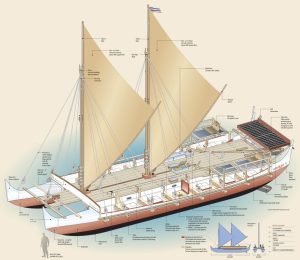68
The Polynesian Voyaging Society (PVS) was founded in 1973 for scientific inquiry into the history and heritage of Hawai`i: How did the Polynesians discover and settle these islands? How did they navigate without instruments, guiding themselves across ocean distances of 2500 miles or more?
In 1973–1975, PVS built a replica of an ancient double-hulled voyaging canoe to conduct an experimental voyage from Hawai`i to Tahiti. The canoe was designed by founder Herb Kawainui Kāne and named Hōkūle`a (“Star of Gladness”).
On March 8th, 1975, Hōkūle`a was launched. Mau Piailug, a master navigator from the island of Satawal in Micronesia, navigated her to Tahiti using traditional navigation techniques (no modern instruments at all).
Think / Pair / Share
- What are some mathematical questions you can ask about voyaging on Hōkūle`a?
- What kinds of problems (especially mathematics problems) did the crew have to solve before setting off on the voyage to Tahiti?
- What are you curious about, with respect to voyaging on Hōkūle`a?
When you teach elementary school, you will mostly likely be teaching all subjects to your students. One thing you should think about as a teacher: How can you connect the different subjects together? Specifically, how can you see mathematics in other fields of study, and how can you draw out that mathematical content?
In this chapter, you’ll explore just a tiny bit of the mathematics involved in voyaging on a traditional canoe. You will apply your knowledge of geometry to create scale drawings and make a star compass. And you’ll use your knowledge of operations and algebraic thinking to plan the supplies for the voyage. The focus here is on applying your mathematical knowledge to a new situation.
One of the first things to know about Hōkūle`a[1] is what she looks like. You can find more pictures at http://hokulea.com.


Problem 1
Here’s some information about the dimensions of Hōkūle`a. Your job is to draw a good scale model of the canoe, like a floor plan.
- Hōkūle`a is 62 feet 4 inches long. (This is “LOA” or “length overall” in navigation terms. It means the maximum length measured parallel to the waterline.)
- Hōkūle`a is 17 feet 6 inches wide. (This is “at beam” meaning at the widest point.)
- You can see from the picture that Hōkūle`a has two hulls, connected by a rectangular deck. The deck is about 40 feet long and 10 feet wide.
Imagine you are above the canoe looking down at it. Draw a scale model of the hulls and the deck. Do not include the sails or any details; you are aiming to convey the overall shape in a scale drawing.
You will use this scale drawing several times in the rest of this unit, so be sure to do a good job and keep it somewhere that you can find it later.
Note: You don’t have all the information you need! So you either need to find out the missing information or make some reasonable estimates based on what you do know.
Problem 2
Crew for a voyage is usually 12–16 people. During meal times, the whole crew is on the deck together. About how much space does each person get when they’re all together on the deck?
- Hokulea homecoming picture by Michelle Manes. ↵

